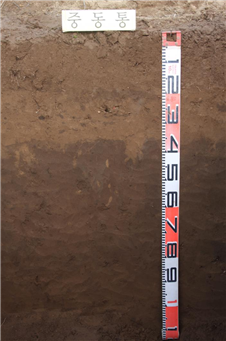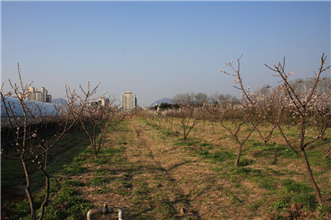

Morphological properties of typifying pedon.
|
|
JUNGDONG SERIES |
Established Series UKT, JFD 20 October, 1969 |
The Jungdong series are members of the coarse loamy, mixed, mesic family of Fluventic Dystrudepts [Haplic Fluvisols (Alumic Dystric) classified by WRB]. They have dark brown (10YR 3/3) fine sandy loam Ap horizons, brown sandy loam BA horizons, dark brown sandy loam Bw horizons, and dark brown sandy loam BC horizons. They occur on continental alluvial flood plains and are derived from alluvial materials.
Typifying pedon: Jungdong fine sandy loam-Chinese cabbage (Colors are for moist soil).
Slope: 2-7%
Elevation: 35 m above m.s.l.
Soil moisture regime: Udic
Soil temperature regime: Mesic
Parent material: Alluvium
Diagnostic features: An ochric epipedon from a depth of 0 to 19 cm and a cambic horizon from a depth of 36 to 62 cm (A cambic horizon from a depth of 36 to 62 cm by WRB).
Described by: Song, K. C., D. C. Noh, and B. K. Hyun, 24 April, 2013.
|
|
|
|
|
Morphological properties of typifying pedon. |
||
Ap - 0 to 19 cm. Dark brown (10YR 3/3) fine sandy loam; moderate medium to coarse granular structure; friable, slightly sticky and slightly plastic; common fine to medium roots; common fine to medium pores; common very fine micas; few worm holes; clear smooth boundary.
BA - 19 to 36 cm. Brown (10YR 4/3) sandy loam; weak coarse platy structure; friable, slightly sticky and slightly plastic; few fine to medium roots; few fine to medium pores; few very fine micas; few worm holes; abrupt wavy boundary.
Bw - 36 to 62 cm. Dark brown (10YR 3/3) sandy loam; weak medium to coarse platy structure; friable, slightly sticky and slightly plastic; few fine roots; few medium to coarse pores; common very fine micas; gradual smooth boundary.
BC - 62 to 160 cm. Brown (10YR 4/3) sandy loam; weak fine to medium platy structure; friable, slightly sticky and slightly plastic; few very fine roots; few fine to medium pores; common very fine micas.
The typifying pedon has an ochric epipedon from a depth of 0 to 19 cm and a cambic horizon from a depth of 36 to 62 cm. That can be classified as Inceptisol. It has an udic soil moisture regime and keys out as Udept. Also it meets the requirements of Dystrudept. It has a slope of less than 25% and at a depth of 125 cm below the mineral soil surface, an organic-carbon content (Holocene age) of 0.2 % or more and no densic, lithic, or paralithic contact within that depth. That can be classified as Fluventic Dystrudept.
The typifying pedon has, in the fraction less than 75 mm in diameter, 15% or more particles with diameters of 0.1 to 75 mm and, in the fine-earth fraction, less than 18% clay in particle-size control section and has mesic soil temperature regime. Therefore it can be classified as coarse loamy, mixed, mesic family of Fluventic Dystrudept.
Type Location: About 20 meters east of Yangseo Tennis Court, Yangsu Ri, Yangseo Myeon, Yangpyeong Gun, Gyeonggi Do (127° 19' 2.5'', 37° 32' 18.8'').
Range in Characteristics: These soils have ochric epipedons and cambic horizons. Depth of soil is more than 2 meters over very contrasting strata and probably more than 4 meters over hard rock. The ground water table usually occurs below 150 cm. Reaction is very strongly acid except where limed. Common fine micas occur throughout the profile. Base saturation is less than 60 percent. Ap horizons are brown or dark yellowish brown fine sandy loam or sandy loam. The Bw horizons are dark yellowish brown, brown, or dark brown sandy loam.
Competing Series and Their Differentiae: These are the Gangseo, Tongcheon, Nagdong, Hwabong, and Bonryang soils. The Gangseo soils are somewhat worse drained and are used for rice paddy. The Tongcheon soils have loamy skeletal textures and higher water table between 50 and 100 cm. The Nagdong and Hwabong soils have sandy textures. The Bonryang soils have coarse loamy over sandy textures.
Setting: The Jungdong soils occur on continental flood plains along the larger rivers and are derived from alluvial materials. Dominant slopes are 1 percent and range from 0 to 2 percent.
Principal Associated Soils: The Jungdong soils are associated with the Hwabong, Gyuam, and Nagdong soils in similar physiographic positions. The Gyuam soils have fine silty textures and higher water tables.
Drainage and Permeability: Well drained. Permeability is probably moderate or moderately rapid and runoff is slow.
Use and Vegetation: Most of these soils are used for peanuts, barley, soybean, radish, buckwheat, cabbage, and similar crops.
Distribution and Extent: The Jungdong soils are of moderate extent and occur on broad alluvial plains along the main rivers throughout the country.
Series Established: Sangju city, Gyeongsangbug Do, 1969. Revised, Yangpyeong Gun, Gyeonggi Do, 2013.
Laboratory data sheets of typifying pedon.
|
Depth (cm) |
Horizon |
( --- Total ---) |
(-- Clay --) |
(-- Silt --) |
(------- Sand -------) |
||||||||
|
Clay |
Silt |
Sand |
Fine |
Coarse |
Fine |
Coarse |
VF |
F |
M |
C |
VC |
||
|
LT |
.002 |
.05 |
LT |
LT |
.002 |
.02 |
.05 |
.10 |
.25 |
.5 |
1 |
||
|
.002 |
- .05 |
- 2 |
.0002 |
.002 |
- .02 |
- .05 |
- .10 |
- .25 |
- .50 |
- 1 |
- 2 |
||
|
- - - - - - - - - - - Pct of ˂ 2mm (3A1) - - - - - - - - - - - |
|||||||||||||
|
0-19 |
Ap |
7.6 |
25.7 |
66.7 |
|
|
10.0 |
15.7 |
31.3 |
29.7 |
4.9 |
0.5 |
0.3 |
|
19-36 |
BA |
7.7 |
26.7 |
65.6 |
|
|
7.0 |
19.7 |
32.1 |
28.5 |
4.4 |
0.3 |
0.2 |
|
36-62 |
Bw |
8.0 |
28.5 |
63.5 |
|
|
9.0 |
19.5 |
31.0 |
28.0 |
4.2 |
0.1 |
1.0 |
|
62-160 |
BC |
9.6 |
28.1 |
62.3 |
|
|
9.4 |
18.7 |
31.3 |
28.5 |
3.3 |
0..1 |
0 |
|
Depth (cm) |
Coarse Fractions(mm) |
˃2mm |
Orgn |
Total |
Extr |
Total |
(-- Dith -Cit --) |
|||||
|
Weight |
Wt |
C |
N |
P |
S |
Extractable |
||||||
|
2-5 |
5-20 |
20-75 |
.1-75 |
Pct of |
|
|
|
|
Fe |
Al |
Mn |
|
|
|
|
|
|
Whole |
6A1c |
6B3a |
6S3 |
6R3a |
6C2b |
6G7a |
6D2a |
|
|
Pct of ˂ 75mm (3B1) |
Soil |
Pct ˂ 2mm |
g/kg |
Pct of ˂ 2mm |
||||||||
|
0-19 |
|
|
|
|
|
1.29 |
|
|
|
|
|
|
|
19-36 |
|
|
|
|
|
0.84 |
|
|
|
|
|
|
|
36-62 |
|
|
|
|
|
0.95 |
|
|
|
|
|
|
|
62-160 |
|
|
|
|
|
0.77 |
|
|
|
|
|
|
|
Depth (cm) |
Ratio/Clay |
Atterberg |
( Bulk Density ) |
COLE |
(- Water Content -) |
WRD |
|||||||
|
CEC |
1500 |
Limits |
Field |
33 |
Oven |
Whole |
Field |
10 |
33 |
1500 |
Whole |
||
|
|
kPa |
LL |
PI |
Moist |
kPa |
Dry |
Soil |
Moist |
kPa |
kPa |
kPa |
Soil |
|
|
8D1 |
8D1 |
4P1 |
4P |
4A3a |
4A1d |
4A1h |
4D1 |
4B4 |
4B1c |
4B1c |
4B2a |
4C1 |
|
|
|
|
Pct ˂0.4mm |
- - g/cc - - |
cm/cm |
-- Pct of ˂2mm -- |
cm/cm |
|||||||
|
0-19 |
1.10 |
|
|
|
1.16 |
|
|
|
19.4 |
|
|
|
|
|
19-36 |
0.90 |
|
|
|
1.30 |
|
|
|
17.8 |
|
|
|
|
|
36-62 |
0.97 |
|
|
|
1.18 |
|
|
|
21.9 |
|
|
|
|
|
62-160 |
0.83 |
|
|
|
|
|
|
|
|
|
|
|
|
|
Depth (cm) |
( NH4OAc Extractable Bases ) |
Acid- |
Extr |
(----- CEC -----) |
Al |
||||||
|
Ca |
Mg |
K |
Na |
Sum |
ity |
Al |
Sum |
NH4- |
Bases |
Sat |
|
|
5B5a |
5B5a |
5B5a |
5B5a |
Bases |
|
|
Cats |
OAc |
+ Al |
|
|
|
6N2e |
6O2d |
6Q2b |
6P2b |
|
6H5a |
6G9a |
5A3a |
5A8b |
5A3b |
5G1 |
|
|
- - - - - - - - - - - - meq / 100g - - - - - - - - - - - - |
Pct |
||||||||||
|
0-19 |
0.7 |
0.1 |
0.4 |
0 |
1.3 |
9.9 |
1.6 |
11.1 |
8.4 |
2.8 |
55.5 |
|
19-36 |
0.3 |
0.1 |
0.4 |
0 |
0.8 |
8.4 |
1.5 |
9.3 |
6.9 |
2.3 |
64.7 |
|
36-62 |
0.2 |
0 |
0.3 |
0 |
0.6 |
9.2 |
1.5 |
9.8 |
7.7 |
2.1 |
73.1 |
|
62-160 |
0.2 |
0 |
0.3 |
0 |
0.6 |
11.4 |
1.5 |
12.0 |
8.0 |
2.1 |
72.7 |
|
Depth (cm) |
(Base Sat) |
CO3 as |
Res |
Cond |
(------ pH ------) |
Acid Oxalate Extraction |
|||||||
|
Sum |
NH4- |
CaCO3 |
|
|
NaF |
KCl |
CaCl2 |
H2O |
Opt |
Al |
Fe |
Si |
|
|
|
OAc |
˂2mm |
|
|
|
|
.01M |
|
Den |
|
|
|
|
|
5C3 |
5C1 |
6E1g |
8E1 |
8I |
8C1d |
|
8C1f |
8C1f |
8J |
6G12 |
6C9a |
6V2 |
|
|
---- Pct ---- |
ohms/cm |
dS/m |
|
1: 1 |
1: 2 |
1: 1 |
|
- Pct of ˂2mm - |
|||||
|
0-19 |
11.3 |
15.0 |
|
|
|
|
3.7 |
4.1 |
4.9 |
|
|
|
|
|
19-36 |
8.9 |
11.8 |
|
|
|
|
3.8 |
4.1 |
4.9 |
|
|
|
|
|
36-62 |
5.7 |
7.2 |
|
|
|
|
4.0 |
4.4 |
4.9 |
|
|
|
|
|
62-160 |
4.8 |
7.2 |
|
|
|
|
4.1 |
4.4 |
5.0 |
|
|
|
|